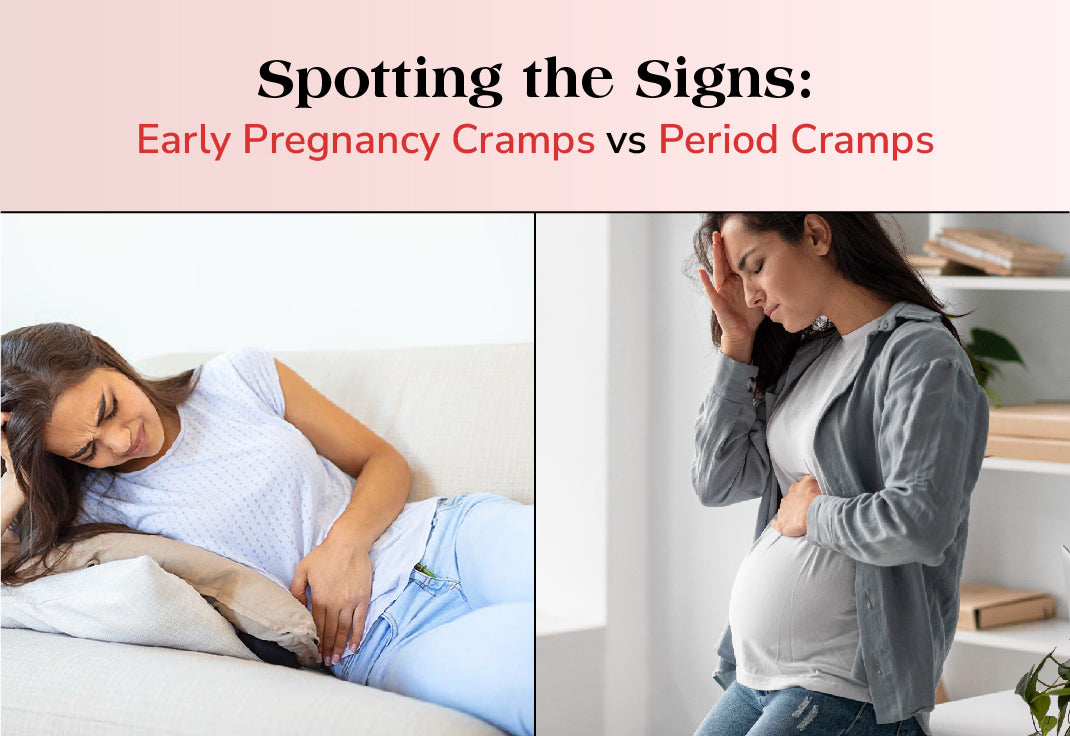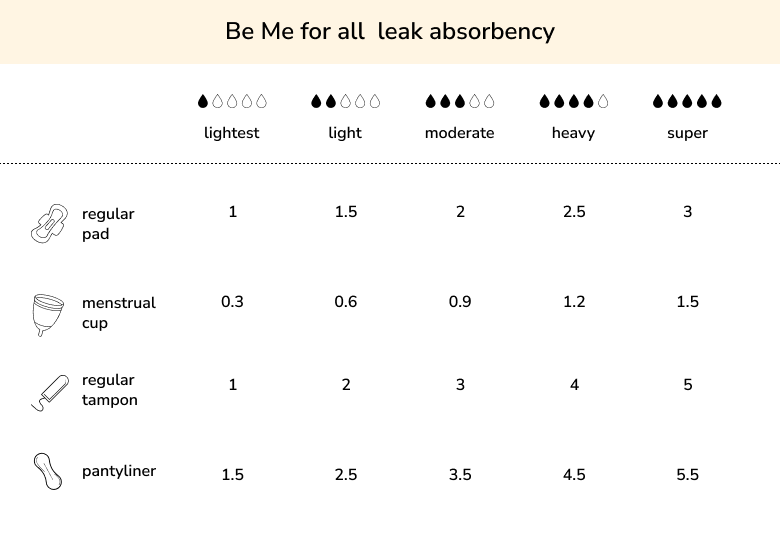
Spotting the Signs: Early Pregnancy Cramps vs Period Cramps - A Side-by-Side Comparison
Published At
Many women find the sensations of period pain and pregnancy cramps feel indistinguishably similar, often leading to confusion: "Is it my period or an early sign of pregnancy?" Both involve uncomfortable abdominal sensations, yet stem from entirely different physiological processes.
Understanding the difference between these cramps is essential for managing discomfort and navigating reproductive health. This guide explores their unique characteristics, symptoms, and what your body is trying to communicate – from dull, throbbing menstrual cramps to often lighter early pregnancy cramps with unique signs like implantation bleeding – helping you interpret these signals.
The Physiology of Period Pain

Period pain, also known as dysmenorrhea, is a common experience for many women during their menstrual cycle. This pain is primarily caused by the contractions of the uterus as it sheds its lining. The endometrium, or the uterine lining, thickens each month in preparation for a potential pregnancy.
When pregnancy does not occur, the body releases prostaglandins, hormone-like substances that trigger the uterine muscles to contract and expel the lining. This process can result in cramping and discomfort in the lower abdomen.
The intensity of period pain can vary significantly from woman to woman. Some may experience mild discomfort, while others may endure severe pain that interferes with daily activities. The level of prostaglandins produced plays a crucial role in determining the severity of the pain.
Higher levels of these substances can cause more intense uterine contractions, leading to greater discomfort. Additionally, underlying conditions such as endometriosis or fibroids can exacerbate period pain, making it more challenging to manage.
Period pain is typically categorized into two types:
- Primary dysmenorrhea: This is the more common form and is not associated with any underlying medical condition. It usually begins a day or two before menstruation and can last for several days.
- Secondary dysmenorrhea: This, on the other hand, is linked to reproductive health issues such as endometriosis, pelvic inflammatory disease, or uterine fibroids. This type of pain often starts earlier in the menstrual cycle and can persist longer than primary dysmenorrhea.
The Physiology of Pregnancy Cramps

Pregnancy cramps, while often similar in sensation to period pain, arise from entirely different physiological processes. In early pregnancy, cramping can occur as the fertilized egg implants itself into the uterine lining. This process, known as implantation, typically happens around 6-12 days after conception and can cause mild cramping and spotting, known as implantation bleeding. These cramps are generally short-lived and less intense than period pain.
As pregnancy progresses, the body undergoes numerous changes that can lead to cramping.
- The uterus expands to accommodate the growing fetus, stretching the ligaments and muscles that support it. This stretching can result in round ligament pain, a common source of cramping in the second trimester.
- Additionally, the increased blood flow to the pelvic region and hormonal changes can contribute to discomfort.
Braxton Hicks contractions, often referred to as "false labor," are another type of cramping experienced during pregnancy. These contractions typically occur in the third trimester and are the body's way of preparing for labor. Unlike true labor contractions, Braxton Hicks are usually irregular, infrequent, and less painful. They can, however, be confusing and cause concern for expectant mothers, especially if they are mistaken for the onset of labor.
Key Differences Between Period Pain and Pregnancy Cramps
While the sensations of period pain and pregnancy cramps can be similar, there are distinct differences in their characteristics and underlying causes. Period pain is primarily associated with the menstrual cycle and the shedding of the uterine lining, whereas pregnancy cramps are related to the changes and adaptations the body undergoes to support a growing fetus.
One key difference is the timing and duration of the cramps. Period pain typically occurs a day or two before menstruation and can last for several days, coinciding with the menstrual flow. Pregnancy cramps, on the other hand, can occur at various stages of pregnancy, with implantation cramps appearing in the early weeks and round ligament pain emerging later. Braxton Hicks contractions are more common in the third trimester and can continue intermittently until labor begins.
The intensity and nature of the pain can also differ. Period pain is often described as a consistent, throbbing, or aching sensation in the lower abdomen, which can radiate to the lower back and thighs. Pregnancy cramps, particularly those related to implantation or round ligament pain, are usually milder and more localized. Braxton Hicks contractions can feel like a tightening or hardening of the abdomen, which may be uncomfortable but not typically painful.
Common Symptoms of Period Pain

Period pain can manifest in various ways, with the most common symptom being cramping in the lower abdomen. These cramps can range from mild to severe and are often accompanied by other symptoms such as:
- Lower back pain
- Discomfort in the thighs.
Some women may also experience a sensation of heaviness or pressure in the pelvic area, making it difficult to engage in normal activities.
In addition to cramping, period pain can be associated with gastrointestinal symptoms. Many women report experiencing:.
- Bloating
- Gas
- Changes in bowel habits during their menstrual cycle.
Diarrhea and constipation are not uncommon, as the prostaglandins that cause uterine contractions can also affect the muscles of the intestines. Nausea and vomiting can also occur, particularly in cases of severe dysmenorrhea.
Other systemic symptoms that can accompany period pain include:
- Headaches
- Dizziness
- Fatigue.
Hormonal fluctuations during the menstrual cycle can trigger migraines in some women, while the physical and emotional toll of dealing with pain can lead to feelings of exhaustion. Mood swings, irritability, and difficulty concentrating are also common, as the body's hormonal balance impacts mental and emotional well-being.
Common Symptoms of Pregnancy Cramps

Pregnancy cramps can present with a variety of symptoms, depending on the stage of pregnancy and the underlying cause of the discomfort. In early pregnancy, implantation cramps are typically mild and may be accompanied by light spotting or implantation bleeding. These symptoms usually resolve within a few days and are often one of the first signs of pregnancy.
As the pregnancy progresses, round ligament pain becomes a more common source of cramping. This pain is usually felt as a sharp or jabbing sensation on one or both sides of the lower abdomen, often triggered by:
- Sudden movements
- Coughing
- Sneezing
It is generally short-lived and can be alleviated by changing positions or resting.
In the third trimester, Braxton Hicks contractions can cause cramping that feels like a tightening or hardening of the abdomen. These contractions are irregular and infrequent, usually lasting less than a minute. While they can be uncomfortable, they are not typically painful and do not indicate the onset of labor. True labor contractions, in contrast, are more regular, increase in intensity, and are accompanied by other signs of labor such as the breaking of water and the loss of the mucus plug.
When to Seek Medical Advice: Period Pain vs. Pregnancy Cramps

While period pain and pregnancy cramps are often normal and manageable, there are instances when medical advice should be sought. For period pain, it is important to consult a healthcare provider if the pain is severe, persistent, or interferes with daily activities. This could indicate an underlying condition such as endometriosis, fibroids, or pelvic inflammatory disease, which may require specialized treatment.
If period pain is accompanied by other concerning symptoms such as heavy bleeding, irregular menstrual cycles, or unusual discharge, it is essential to seek medical evaluation. These symptoms could signal hormonal imbalances, infections, or other reproductive health issues that need to be addressed. A healthcare provider can perform a thorough examination, including pelvic exams and imaging tests, to determine the cause of the symptoms and recommend appropriate treatment.
In the case of pregnancy cramps, it is important to seek medical advice if the cramps are severe, persistent, or accompanied by other concerning symptoms such as heavy bleeding, fever, or severe back pain. These could be signs of complications such as miscarriage, ectopic pregnancy, or preterm labor, which require immediate medical attention. Regular prenatal check-ups are essential for monitoring the health of both the mother and the baby, and any unusual symptoms should be reported to a healthcare provider promptly.
Natural Remedies for Period Pain and Pregnancy Cramps
Managing period pain and pregnancy cramps can often be achieved through various natural remedies that provide relief and improve overall well-being.
For period pain:
- Applying heat to the lower abdomen can help relax the uterine muscles and reduce cramping. A heating pad, warm water bottle, or warm bath can be effective in alleviating discomfort.
- Additionally, gentle exercise such as walking, yoga, or stretching can improve blood flow and release endorphins, which act as natural pain relievers.
Herbal remedies can also be beneficial for managing Period Pain:
- Chamomile tea
- Ginger tea
- Peppermint tea
- Have anti-inflammatory and antispasmodic properties that can help soothe cramps and reduce bloating. Supplements such as:
- Magnesium
- Vitamin B6
- Omega-3 fatty acids
For pregnancy cramps, the following can help prevent and alleviate discomfort:
- Staying hydrated and maintaining a healthy diet.
- Drinking plenty of water.
- Consuming foods rich in fiber.
- Avoiding excessive caffeine and sugar.
- Gentle exercise, such as prenatal yoga or walking, can also help strengthen the muscles and ligaments supporting the uterus, reducing the risk of cramping.
- Applying heat to the lower abdomen or taking a warm bath can provide relief from round ligament pain.
- Practicing relaxation techniques such as deep breathing or meditation can help manage stress and discomfort.
Lifestyle Changes to Alleviate Cramps and Pain

Incorporating certain lifestyle changes can significantly reduce the frequency and severity of period pain and pregnancy cramps.
- Maintaining a balanced diet rich in fruits, vegetables, whole grains, and lean proteins can provide essential nutrients that support reproductive health.
- Reducing the intake of processed foods, caffeine, and alcohol can also help minimize inflammation and hormonal imbalances that contribute to cramping.
- Regular physical activity is another important factor in managing cramps and pain. Engaging in moderate exercise for at least 30 minutes a day can improve circulation, reduce stress, and release endorphins, which act as natural painkillers. Activities such as walking, swimming, and yoga can be particularly beneficial for improving overall fitness and flexibility, which can help alleviate cramping.
- Stress management is crucial for reducing the impact of period pain and pregnancy cramps. Chronic stress can exacerbate pain and discomfort, so it is important to practice relaxation techniques such as deep breathing, meditation, and mindfulness.
- Ensuring adequate sleep and rest is also essential for overall well-being and can help the body cope better with the physical and emotional demands of menstruation and pregnancy.
- Seeking support from friends, family, or a healthcare provider can also provide valuable emotional and practical assistance.
Conclusion: Listening to Your Body and Understanding Its Signals
Understanding the difference between period pain and early pregnancy cramps, though tricky, is essential for managing discomfort and making informed reproductive health decisions. Recognize unique characteristics: period cramps are often sharper and consistent, possibly with bloating or mood swings, while early pregnancy cramps may be mild, intermittent, and can come with nausea or light spotting, helping you interpret your body's signals and take appropriate action.
It's important to listen to your body and seek medical advice for severe or persistent pain, unusual symptoms, or concerns about reproductive health. Early intervention improves well-being. Incorporating natural remedies, lifestyle changes, and stress management, alongside regular check-ups and open communication with healthcare providers, empowers women to effectively manage these common experiences for a more comfortable journey.









